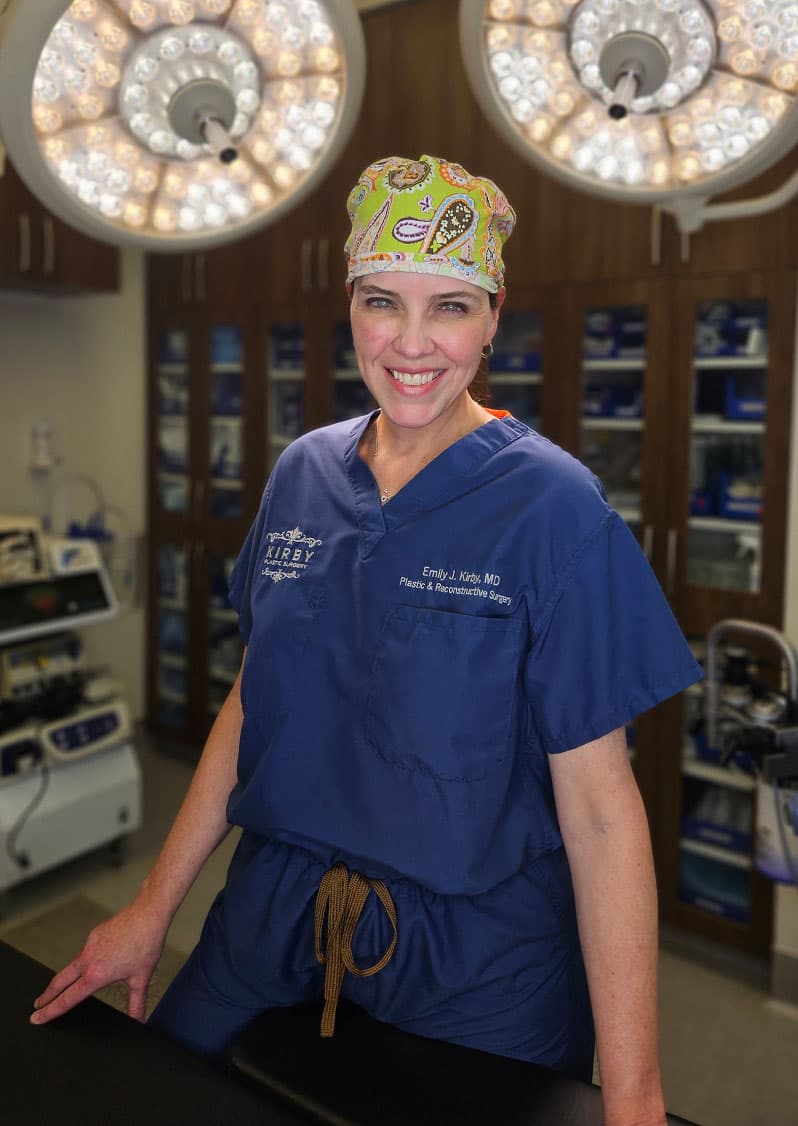Lip Rejuvenation Fort Worth

Lip augmentation is a procedure designed to rejuvenate the appearance and shape of the upper and lower lips. Some individuals are blessed with lip fullness that provides an adequate portion of vermilion (the pink part of the lips). This allows for an easier application of lipstick or coloring. This amount of aesthetically pleasing vermilion show is not present in everyone. It is even difficult for some individuals to apply lipstick because of the lip deficiency. Lip augmentation can be performed to provide fullness and pout to the central part of the lip.
It is evident with aging that there is some decrease in fullness of the lips, resulting in less pout and an increase in the fine wrinkles of the upper and lower lips. There are procedures (CO2 laser and peels) that have shown improvement of the wrinkles of the lips. Lip augmentation can also improve a minimal amount of wrinkles and at the same time enhance the fullness of the lips.
Board Certified Plastic Surgeon Dr. Emily J. Kirby performs lip augmentation in Fort Worth using several surgical and non-surgical techniques, including dermal fillers, fat injection, and lip implants.
Female Plastic Surgeon Fort Worth
- Board-Certified Plastic Surgeon
- Over 14 years of experience in private practice
- Founder and Medical Director of Kirby Plastic Surgery, Kalos Medical Spa, and City Surgery Center—a Quad A-accredited, state-of-the-art facility located onsite
- Specialist in breast surgery and body contouring, including postpartum
- Castle Connolly Top Doctor since 2019
- First female Chief of Plastic Surgery, Texas Health Resources Harris Methodist Hospital
What are my lip augmentation options?
- Fillers. Temporary fillers such as Juvéderm® can be used to augment the lips for up to 1 year.
- Fat injection. Fat injection, also called fat transfer, has been used for “permanent” augmentation, but the results are variable and there is some loss of the tissue after 1 year.
- Implant. Gortex® and silicone are implants that can be used to augment the lips. They are permanent and will not shrink over time.
Your consultation
Your consultation takes about one hour. You’ll spend most of that time with Dr. Kirby discussing your goals, concerns, and questions, and learning how Dr. Kirby tailors the procedure to address each of these. You’ll also get to meet our nursing staff who will take your vitals and review your medical history, and our patient care coordinator will schedule your procedure and help guide you through the process from start to finish.
What kind of anesthesia will I have for lip augmentation?
Fillers are injected in the office with local anesthesia. Lip augmentation using an implant is performed under local anesthesia at the surgery center and usually requires approximately 40 minutes for one lip. Sedation can be provided for comfort and you can be expected to return home the same day if no other procedures are performed.
Where will my lip augmentation incisions be?
Fillers are injected using a small needle in the office. Augmentation is performed using an incision along both corners of the mouth to allow introduction of the material into the lip. The incisions are very small (1/8 of an inch) and usually are not even apparent after the procedure is performed. You should expect a scar in front of each corner of the mouth, within the red portion of the lip. The scars are placed in natural skin creases and will fade with time. This usually takes less than 3 months.
How long is lip augmentation surgery?
The operating time will vary depending on your specific procedure and whether one or both lips are augmented. Generally, it takes approximately 1 hour to enhance both lips. If additional procedures are performed, the surgery time is longer.
- Key Benefits
- Glossary
- Allows for precise adjustments to lip volume and shape
- Improves lip symmetry
- Immediately visible results with most lip augmentation procedures
- Non-surgical options
- Autologous Fat Transfer: A procedure that uses the patient’s own fat, harvested from another part of the body, to enhance lip volume, providing a natural-looking result.
- Biocompatible Materials: Substances that are compatible with the human body and can be safely used for medical applications, such as lip implants, without causing adverse reactions.
- Cannula: A thin, tube-like instrument used in both fat transfer procedures for lip augmentation and some filler injections to minimize bruising and tissue trauma.
- Dermal Fillers: Injectable substances used to add volume to the lips; commonly made from hyaluronic acid, a substance that naturally occurs in the body.
- Hyaluronic Acid (HA): A naturally occurring substance in the skin that provides volume and hydration, commonly used in dermal fillers for lip augmentation.
- Lip Augmentation: Cosmetic procedures aimed at increasing the fullness and plumpness of the lips through injectables, fat transfer, or implants.
- Lip Implants: Devices inserted into the lips to provide permanent lip enhancement, made from materials designed to feel natural and be compatible with body tissues.
- Local Anesthesia: Medication administered to prevent pain during a procedure by numbing a small area.
- Microfat Grafting: A technique of fat transfer that uses smaller amounts of fat to achieve a more subtle and precise volume enhancement in the lips.
- Perioral Area: The area surrounding the mouth, including the lips and the skin immediately adjacent, often targeted in conjunction with lip augmentation for a harmonious aesthetic result.
- Recovery Time: The period after surgery during which the patient heals. This includes time for swelling and bruising to subside, and for the patient to gradually return to normal activities, typically ranging from a few days to several weeks. Recovery can be streamlined, but not rushed.
- Tumescent Technique: A method used in liposuction (for harvesting fat for transfer) that involves injecting a large volume of diluted local anesthesia into the fatty tissue, reducing bleeding and discomfort.
What are the risks?
Scars of the lip usually heal so well that they are usually imperceptible, but it is important to remember that all scars are permanent. The width, height, and color of scars are unpredictable. As with any surgical procedure, small sensory nerves to the skin surface may be cut when the incision is made or when skin is undermined. Portions of your lip will feel numb or have less than full feeling. The sensibility in these areas gradually returns, usually with 2 to 3 months as the nerve endings spontaneously heal. During the healing process, the skin of the lip may become hypersensitive for a period of time. Some diminished sensibility may last indefinitely.
“She was not only professional, reassuring, and confident, but also friendly.”
How do I prepare for lip augmentation surgery?
Prior to any procedure, it is necessary to review medications you are taking that may affect your surgery. You may be asked to stop or to adjust some medications you are on. As always, it is important to include supplements on your list of medications. Aspirin and aspirin products (Alka-Seltzer®, Carisoprodol, Excedrin®, Goody’s®, Midol®), anti-inflammatory medications (except acetaminophen, or Tylenol®), and herbal supplements must be avoided for 10 days prior to your surgery. Dr. Kirby will discuss your medications with you. Learn more about which medications and supplements to avoid.
Depending on your medical condition, you may be asked to get lab testing or a medical checkup prior to your surgery.
Tobacco products impair your body’s ability to heal. You will be asked to stop smoking for 6 weeks prior to any surgery. Tobacco step-down products such as chewing gum and Nicoderm® continue to provide your body with tobacco and must be stopped as well. Please ask Dr. Kirby if you will need assistance with quitting.
Be sure to arrange for a responsible adult to drive you to and from your surgery. You will need someone to stay with you the night following your surgery as well.
You will receive specific instructions for your surgery day from Dr. Kirby’s office.
Dr. Emily Kirby ensures that every plastic surgery patient receives Enhanced Recovery After Surgery (ERAS) care to optimize recovery time and minimize pain. Dr. Kirby uses innovative pain reduction techniques, such as numbing anesthetics and small doses of different types of medications, to reduce discomfort from many angles.
“Dr. Kirby has created the most amazing experience. She is thorough and intuitive, sincerely cares about the work she does and perfectly marries listening to what you want and what science says.”
—Actual patient
What is my recovery from surgery like?
No dressings are necessary. Antibiotic ointment will be applied to the entire lip and over the stitches. Ice packs are not necessary. There is usually a moderate amount of swelling and very little if any bruising. You should try to sleep with your head elevated to help reduce the amount of swelling. Your lips usually feel somewhat firm immediately after the procedure, but will soften with time. During the first 1 to 2 weeks your lips will feel and look swollen. The swelling will start to subside after the first postoperative week. It may take as long as 2 months for the last bit of swelling to recede.
You may bathe the day after surgery. The antibiotic ointment should be applied twice a day for one full week. Be sure to wear sunscreen of at least SPF 15 or greater when outside to protect the scars from sunlight during the healing process.
Initial discomfort is controlled with oral pain medication. Stitches are dissolvable and should be gone after one week. You should avoid eating items that are hard or that have rough or sharp edges (like Doritos®). You should be extremely careful about placing items in your mouth, as your lips will initially be numb and you may not be able to identify injury or burn to your lips.
Caring for incisions after plastic surgery
Proper incision care is essential to a smooth recovery and ensuring your scars heal beautifully. In this video, Dr. Kirby shares what you need to know about caring for your incisions as you heal from your plastic surgery procedure.
References »
Wollina U, Goldman A. Facial vascular danger zones for filler injections. Dermatology and Therapy. 2020 Nov;33(6):e14285. doi: 10.1111/dth.14285.
Hamman MS, Goldman MP. Minimizing bruising following fillers and other cosmetic injectables. J Clin Aesthet Dermatol. 2013 Aug;6(8):16-8.
Crowley JS, Kream E, Fabi S, Cohen SR. Facial Rejuvenation With Fat Grafting and Fillers. Aesthetic Surgery Journal. 2021 May 18;41(Suppl 1):S31-S38. doi: 10.1093/asj/sjab014.
Dayal A, Bhatia A, Hsu JT. Fat grafting in aesthetics. Clinics in Dermatology. 2022 Jan-Feb;40(1):35-44. doi: 10.1016/j.clindermatol.2021.08.010.
Tonnard P, Verpaele A, Carvas M. Fat Grafting for Facial Rejuvenation with Nanofat Grafts. Clinics in Plastic Surgery. 2020 Jan;47(1):53-62. doi: 10.1016/j.cps.2019.08.006.
Cavallini M, Gazzola R, Metalla M, Vaienti L. The role of hyaluronidase in the treatment of complications from hyaluronic acid dermal fillers. Aesthetic Surgery Journal. 2013 Nov 1;33(8):1167-74. doi: 10.1177/1090820X13511970.
Wang J, Fan J, Nordström RE. Evaluation of lip augmentation with Gore-Tex facial implant. Aesthetic Plastic Surgery. 1997 Nov-Dec;21(6):433-6. doi: 10.1007/s002669900152.
Lassus C. Restoration of the lip roll with Gore-Tex. Aesthetic Plastic Surgery. 1997 Nov-Dec;21(6):430-2. doi: 10.1007/s002669900151.
- Discuss your goals and concerns
- Obtain a unique female perspective
- Review convenient financing options
- call or TEXT (817) 292-4200 or contact us today!
Area Served:

Medically reviewed by Dr. Emily J. Kirby — Updated on Feb 7, 2025
